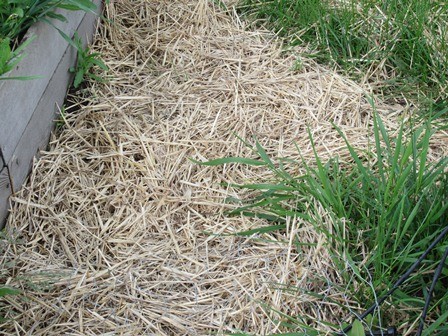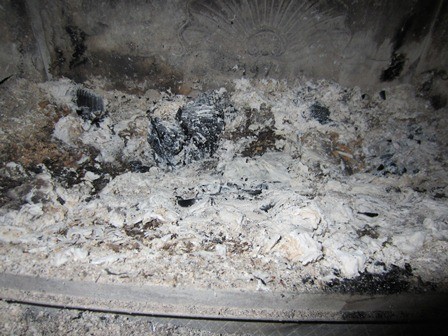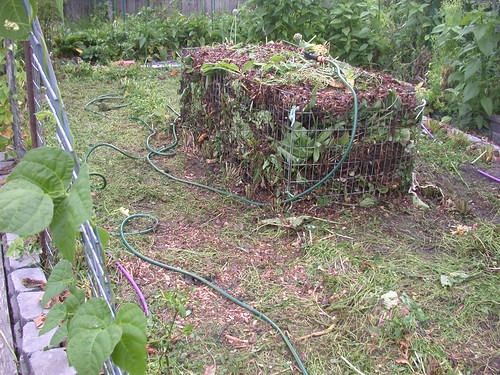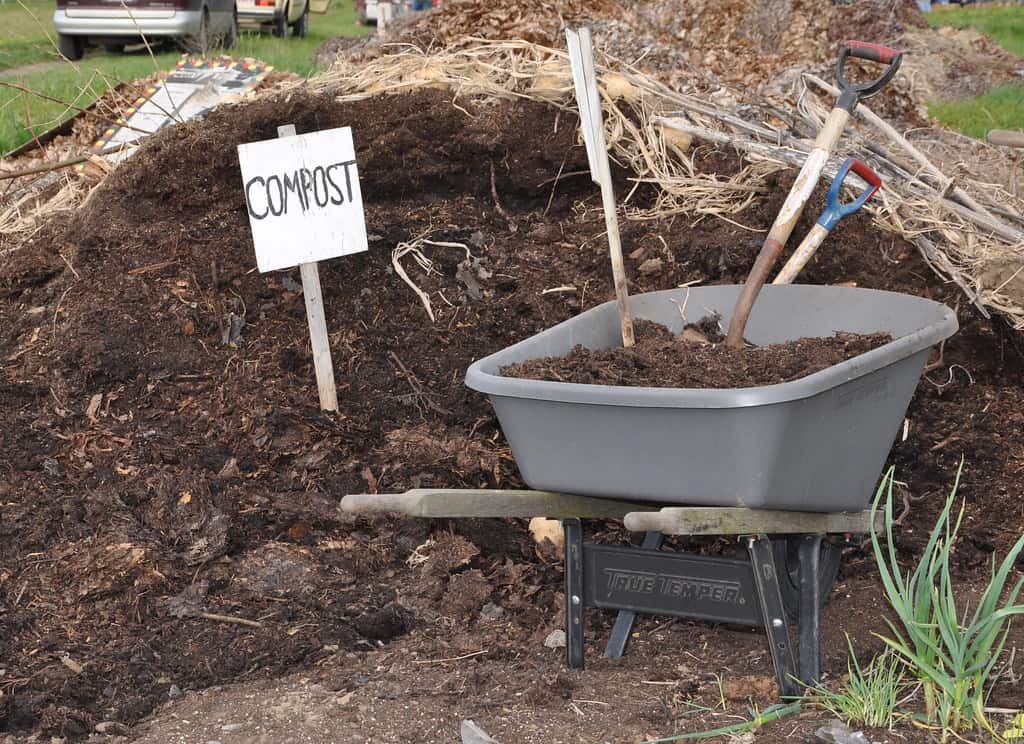Learn how to start a compost pile or compost heap. Composting is appealing because it has many benefits. It’s easy to do and enriches the soil from fruit and vegetable scraps, paper and cardboard, and yard material. These are things you would usually throw away — filling up the landfills — but with composting, nothing goes to waste!
You can compost in most areas. First, you’ll need to consider whether you will start a compost pile or use a compost bin or tumbler. Before you decide, there are factors to consider.
How to Compost at Home for Beginners Guide
Space is a big consideration. If you have some land, you can use concrete blocks or bricks to build a compost heap. You will use these blocks to contain your compost. It will also help to keep the scavengers away.
If you don’t want to define the area with blocks, you can start a heaping compost pile all on its own. This works well if you have an out-of-the-way area on your property.
When your compost pile is exposed, it will be up to you to rotate it. You will do this with a shovel or rake, turning over the organic matter a few times a month. This is more labor-intensive than having a composting bin that you can rotate.
Also, know that with compost heaps and compost piles, it will smell. You may attract rats, mice, flies, and other critters.
Depending on where it is on your property, this can affect your neighbors as well.
If you have wildlife, live in an HOA, or have a smaller outdoor area, you may opt for an enclosed compost bin. In these instances, an outdoor compost tumbler can be a great option. It will keep your organic matter and food scraps contained. It won’t attract flies, wildlife; nor will it smell. It’s all contained and easy to turn over once a week by simply rotating it.
Getting Started Composting
If time is a factor, it may be easier to use a compost bin as well. Compost bins are easy to turn over and may be less labor intensive than raking and turning over an outdoor compost heap with a shovel or rake.
After seeing many different types of composting set ups, we learned you can probably compost wherever you live.
In addition, you can compost without using worms — vermicomposting — which might be more appealing.

How to Compost at Home for Beginners
Household composting is the process of converting kitchen and yard waste into valuable fertilizer. When a family’s compostable materials go to a compost bin instead of the trash can, waste can be reduced by up to 30%.
Our family eats a lot of fresh fruits and vegetables. However, before composting, we tossed a lot of it as well.
There’s the not-so-great-tasting parts as well as some stems, cores, pits, and rinds. There are the tops of carrots and pineapples, peels from citrus, and watermelon rinds.
Sometimes, we unfortunately forget about produce and it goes bad. All of this is wasted. However, when you compost these vegetable and fruit scraps, you use all of it.
Think of composting like you think of recycling: an easy step you take to preserve the environment. Whether you use the compost for your garden or leave it to decay, you are creating organic matter which benefits your nat the microbes in the soil.
Like recycling and using less overall, composting can become second-nature. Once you get started, composting is easy.
Why Should You Compost at Home?
- Compost turns into a valuable fertilizer for gardens and lawns
- Composting saves up to ⅓ of landfill space
- You use up all of your produce scraps, coffee grounds, eggshells, tea bags, etc.
- Compost is easy to dispose of if unneeded
How to Compost at Home for Beginners in Five Steps
1. Get a kitchen compost bin.
A stainless steel compost pail or other compost container will make kitchen clean-up easier, and you can store it in your kitchen. You toss your scraps inside and then as it fills, take it outside to dump in the compost pile or tumbler.
Kitchen compost bins are affordable and simple. You can find them at most home stores and gardening stores. In a pinch, you can use an empty coffee can or other container such as the plastic clamshell from leafy greens. However, once you get into composting, you will like having a kitchen compost bin.To reduce smells in your kitchen from composting, opt for a stainless steel compost pail with an air filter. Or you can use most any pail with a secure lid.
In addition, the stainless steel composting pails and other containers made for this purpose are designed to look nice on your kitchen counter.
Other Options
Two other options, if you don’t have the space or want something “permanent” on your countertop:
1. Empty plastic clamshell container from leafy greens
I like these better than the ones from strawberries because they don’t have holes on the bottom. You can fill it up over a day or two, and then dump it in your compost. Then, you can rinse and reuse, or recycle the container.
2. Gallon-sized plastic bag
Another option is to keep a gallon-sized, locking plastic bag in your refrigerator or freezer. You can fill it up with your scraps. When it gets full, you can start another bag, or if you have time, dump it in the compost.
If you kept the bag in the freezer, you can reuse it for new scraps. If you kept it in the fridge, you may or may not want to reuse it.
2. Know what inside household waste is compostable.
What to compost? This is easy. You likely will have more things to compost than you realized. This is what makes composting fun because you can feel good about not letting anything go to waste.
From inside your home, think fruit and vegetable scraps. This includes most all produce scraps from your fresh fruits and vegetables. We use onion skins, not extra onion pieces. If you have moldy fruits and vegetables in the refrigerator that you forgot about, at least you can compost them.
You can use cooked vegetables (we don’t) if they don’t contain added oils, butter, or meat fats.
What to Compost
Some examples of what you can put in a compost pile or compost machine include:
Peels from fruits and vegetables
Everyday examples include rinds from mandarins, oranges and grapefruits; carrot and potato peels; avocado peels and pits.
Think of how much you throw away from a pineapple. However, you can compost the top (the crown) as well as the core and all of the skin.
You can add banana peels but know they often attract fruit flies.
Fruit and vegetable scraps are considered greens. They add nitrogen to your compost.
Cores, pits, and seeds
You can compost pear and apple cores, plum and peach pits, seeds and the tops from peppers.
Rinds, stems, leaves
Compost carrot tops, leaves from beets, stems from cilantro, and all those parts we don’t use from a head of cauliflower and lettuce.
We grow potatoes in containers, and we compost the leaves from them.
Before putting your watermelon rind in the compost, you may want to give it to your chickens first. Otherwise, put your watermelon rinds and seeds in the compost instead of the garbage.
After Halloween, if you have a carved pumpkin, toss it in the compost pile.
Think of how many vegetable scraps and fruit scraps you throw away every day. Many times we forget about produce in the refrigerator or on the counter, and they rot. Instead of throwing them away, you can compost them.
It’s amazing to put them to use and keep them out of the landfills.
Cardboard, paper, paper towel rolls
In addition to scraps from fruits and vegetables — the greens — you need browns in your compost pile.
Browns add carbon to compost.
You can get many browns from outside, in nature, as well as from inside your home.
Some examples of browns to compost include newspaper, printer paper, coffee filters, napkins, paper towel and toilet paper rolls.
In addition, you can tear up cardboard boxes to include in compost.
What to compost from inside
You can compost:
- Shells from peanuts and nuts
- Egg shells
- Tea bags as well as loose tea
- Coffee grounds and the filter papers
- Paper towel rolls and toilet paper rolls
- Newspaper, cardboard, paper towel and toilet paper rolls, shredded paper
- Coffee Grounds for Plants: Recyclable Miracle or Harmful Additive?
Later we discuss the C:N ratio in composting. This is the ratio between the Carbon (brown) to Nitrogen (green).
3. Know what outside waste is compostable.
Likewise, you can add yard waste directly into your outside compost area. Instead of putting your grass clippings in a garbage bin, you can compost them.
If autumn where you live means you have to rake leaves, gather them up to add to your compost pile.
Other yard debris such as straw, wood ash, weeds, etc. There’s a lot of compostable materials you can use. You can even chop twigs, tree branches, trunks, etc.
Basically, if it grows, it goes! You can toss many things in your compost heap. As a general rule, for the beginner composter, this excludes meat and dairy products.
What to compost from yard waste
- Grass clippings
- Weeds
- Tree limbs, branches
- Hedge trimmings
- Wood ash
- Leaves
- Hay, straw
4. Think about worms. Do I need worms to compost?
Decide if you want to have worms and if you want to start a worm farm. Composting with worms is called vermicomposting.
Worms aren’t essential to compost but it’s important to decide if you will want to vermicompost. If you want to use a bin rather than a compost pile, there are special vermicomposting bins.

5. Choose a composting system. Pile or Bin?
There are two decisions to then make.
Are you going to make an outdoor compost pile or use a compost container / tumbler?
Compost Pile / Compost Heap
You can make your own compost pile by layering compost materials over bare earth, alternating with dry materials such as leaves, straw, or sawdust.

Your compost pile needs to remain moist. During certain parts of the year, depending where you live, you may want to cover it with wood or plastic sheeting to keep in moisture and warmth.
Add additional compost materials to the top of the pile, and harvest compost from the bottom. The pile will need to be turned every few weeks with a shovel in order to aerate the compost.

We know a few people with a heaping pile of compost on their property. They add to it but pretty much just let it do it’s thing naturally.
Compost Bin / Compost Tumbler / Compost Machine
Alternatively, you can buy a compost bin or compost tumbler. Outdoor compost tumblers take much of the work out of composting. You simply turn the handle to rotate the compost.
Compost tumblers and compost bins make storage easy and more sightly. They will minimize the smell and not attract scavengers and other wildlife.
If you live in an HOA or have neighbors close by, you may choose a compost bin over a composting pile.
Other things to consider are the heat. For example, living in the southwestern part of the United States, you may not want an exposed compost pile in the summer unless it’s far from your living area.
You can even use continuous-use composters indoors, where raw compost materials are kept separate from completed compost. Indoor composters are ideal for people with small balconies or not much yard space.

Depending on how much land you have, you may opt for a compost machine. There are many types available in different sizes. Owning one may make it more appealing to compost.
C:N Ratio Browns to Greens
While you will be tempted to just start tossing everything in the pile, it’s important to know the correct ratio of browns to greens.
This is considered the C: N ratio.
- The C stands for Carbon. These are the browns.
- The N stands for Nitrogen. These are the greens.
Carbon to Nitrogen ratio compost
You want to aim for 25 – 30 parts carbon to one part nitrogen. This means the C:N ratio should be 25:1 approximately.
This is the optimum rate for decomposition.
Figuring out which is which is easy when composting things from inside the home. Scraps from fruits and vegetables are greens while paper products are browns.
Outside, grass clippings, are considered green material.
Straw, hay, logs, dried leaves are brown. Also note that wood materials don’t break down as easily so you may unknowingly have a higher carbon ratio than you think.
What goes at the bottom of the compost pile
You will want to start with a base layer in your compost pile or in your compost bin.
Start your compost by layering a thick layer of shredded cardboard — thicker when starting a compost pile on the ground –as a base. Boxes are ideal.
Then add whatever you have, keeping in mind the Carbon to Nitrogen (Brown to Green) ratio.
Keeping Compost Pile Moist
It’s essential to keep the pile moist. In addition, you will want to turn it every five days or so.
Starting a Compost Pile
When we started composting, it was really exciting to be able to use the scraps from all of our fruits and vegetables.
We didn’t use fertilizers before and were looking forward to seeing how much better our garden would grow using compost.
It was less wasteful overall and motivated us to buy more organic produce knowing we would use all of it — either by eating it or composting it.
We were happy to be minimizing the methane gas by-products as well.
We are happy to be using compost to grow an awesome garden. It’s satisfying to use everything again and again.
Use Your Compost to Fertilize Your Garden or Yard

Compost is a great organic fertilizer, and can be used for planter boxes, raised gardens, indoor potted plants, and your yard and lawn. It also saves the cost of bringing in extra dirt.
While it may seem daunting to begin composting, it’s easy to begin to compost at home.
Whether you are a beginner at composting or have done it for years, you will love being able to reuse what would otherwise be kitchen waste and scraps filling up our landfills.
Deciding Whether to Compost
You have three choices for disposing of your compostable materials. You can either:
- Use your own compost in your garden
- Dispose of your compost using curb-side waste removal
- Take your compostable materials to a compost site
If you have no need for compost in your own garden or yard, and do have curbside residential garbage pick up, your service provider might offer yard waste and compost service.
You may already have it.
Our town offers this in the form of a green barrel designed for yard waste and leaves.
Residents simply deposit their compostable materials directly from their compost pails to their curb-side barrels.
Be sure to check your city’s guidelines.
There are increasingly more areas (Vancouver, Canada comes to mind) that requires the residents to compost their food scraps.
If your curb-side garbage service does not allow for compostable materials in its yard waste bin, you’ll want to find a local compost removal service or compost buying service.
How to Start a Compost Pile
Think about the plant and kitchen waste you can recycle to create rich, nutritionally-dense matter.
It is an organic way to fertilize your garden. By composting, you are giving the soil organic material that it can use.
The compost you create will look dark and be crumbly like soil which will enable you to blend it in easily for your plants.
Consider an area where you can start a composting system and how much room you have. You may want to locate it closer to where you will use it, near the garden, etc.
Getting Started Composting
It’s important for you to consider which composting method will work best for you.
Will you vermicompost? Will you start a compost pile or begin composting with a tumbler?
It may seem daunting to start composting but once you make these decisions upfront, the rest will fall into place.
You will learn about the proper ratio of paper, water, and plant matter.
You will feel good about using leftover fruit and vegetable scraps. Think of how much waste there is from stems, pits, seeds, cores, peels, and more.
In no time, you will be on your way to composting and contributing to your gardens with soil amendment you created organically.
Worm Farm – Should You Start One?

